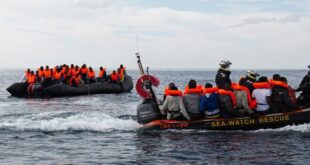A recent study by the REACH initiative, funded by UNHCR, has found that European Union measures implemented in Libya since the beginning of last year have led to an increase in internal trafficking routes and that the living conditions of migrants in the country have not improved.
Migration policies implemented by the EU in Libya since the beginning of 2017 have led to an increase in trafficking routes to the country and inside of it, a new UNHCR-funded study by the REACH initiative has found.
At the same time, departure points along the coastal area have increased, with a sharp rise in trafficking centres along the eastern coast, especially in Tobruk, Ejdabia, Jalu, Marada and Sirte. The study focuses on changes and trends in migration routes in Libya.
Rising number of migrants go through Algeria and Chad
The conclusions of the document state that entrance points along the southern borders of Libya have diversified, with refugees and migrants arriving ever more in the country from Algeria and Chad. The increase in trafficking hubs on the eastern coast corresponds to an increase in investment in anti-trafficking operations that began in the west in early 2017.
Following an increase in Coast Guard checks, refugees and migrants that want to transit through Italy are said to stay for longer periods in warehouses and hidden lodgings along the coast, with extremely limited movement, the study noted. While waiting to be taken to the coast to leave towards a European country, the migrants are living in poverty, without steady employment, relations with the community and shelter in which they can protect themselves.
Migrants’ conditions in detention centres unchanged
Those interviewed for the REACH research said that the situation of refugees and migrants outside of detention centres in the country – which includes the risk of kidnapping, extortion by militants, and restricted movement – has remained unchanged since early 2017. Refugees and migrants that are in the country mainly for employment tend to remain in the same place and move as little as possible, in order to build their social and economic networks and minimize their exposure to risk.
The study added that knowledge of the situation in Libya and migration measures currently implemented in the country do not influence the decision of refugees and migrants to remain in Libya or not. According to the information gathered, there has been an overall drop in the arrival of refugees and migrants along the southern coast and in the main transit hubs along the coast of the country. There have also been reports, it added, of an increase in refugees and migrants held in unofficial detention centres.
© ANSA
 THE AFRICAN COURIER. Reporting Africa and its Diaspora! The African Courier is an international magazine published in Germany to report on Africa and the Diaspora African experience. The first issue of the bimonthly magazine appeared on the newsstands on 15 February 1998. The African Courier is a communication forum for European-African political, economic and cultural exchanges, and a voice for Africa in Europe.
THE AFRICAN COURIER. Reporting Africa and its Diaspora! The African Courier is an international magazine published in Germany to report on Africa and the Diaspora African experience. The first issue of the bimonthly magazine appeared on the newsstands on 15 February 1998. The African Courier is a communication forum for European-African political, economic and cultural exchanges, and a voice for Africa in Europe.

























